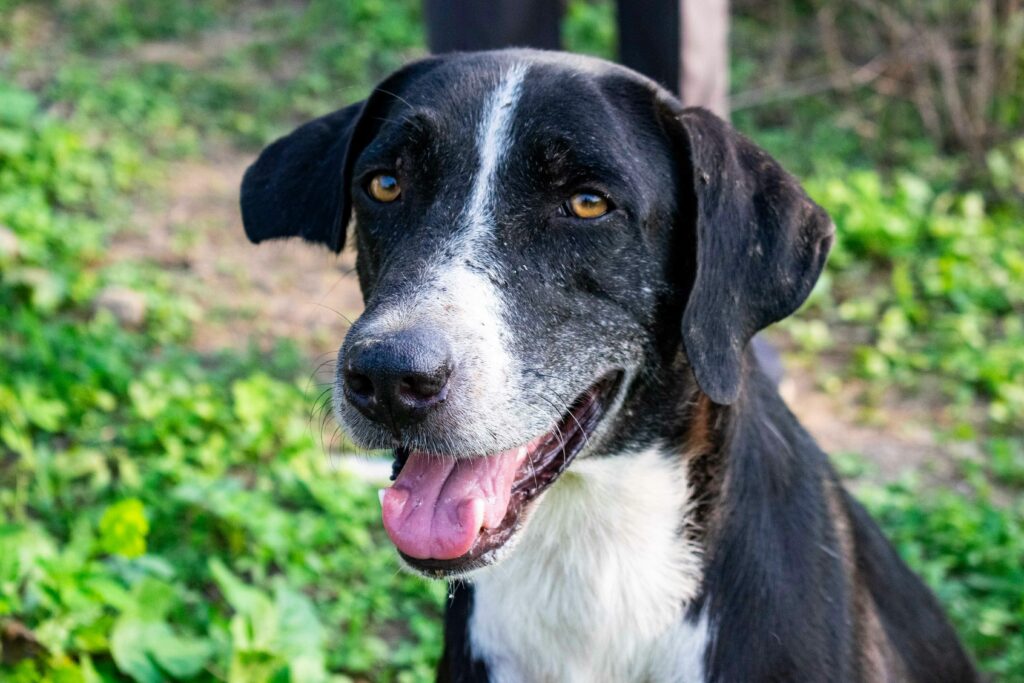
Canine Cognitive Dysfunction (CCD) is like Alzheimer’s in dogs, with symptoms like forgetfulness, memory lapses, and disorientation. Be alert to these signs and consult a vet if you observe any behavior changes.
Key facts:
- On average, dogs are living longer.
- An increased lifespan also means that dogs are more likely to experience age-related diseases, including cognitive decline, similar to aging humans.
- Canine cognitive dysfunction (CCD) is often referred to as dog dementia.
- CCD affects approximately 14-35% of dogs over 8 years of age.
- Although there is no cure for dementia in dogs, various strategies can help manage the condition and improve quality of life.
In the last 40 years, the lifespan of our canine companions has increased. This is amazing for us pet parents, as we get to spend more time with our furry best friends, but the downside is that in the latter years, dogs can experience more age-related medical conditions, including cancer, arthritis, and cognitive decline, just like us humans. This is why it’s important to have a daily routine that improves quality of life.
Canine cognitive dysfunction (CCD), often referred to as dog dementia, affects a significant number of senior dogs. According to studies, CCD affects about 14-35% of dogs over 8 years of age, depending on their age and health status.
Understanding the signs and symptoms of dementia in dogs can help you provide better care and improve your furry friend’s quality of life.
When Do Dogs Get Dementia?
Signs of CCD usually start between 7-11 years old. It can vary based on the dog’s breed, lifestyle, and health. Smaller breeds live longer and become seniors later. Larger breeds may show dementia signs earlier. A 2001 study found that 28% of 11-12 year old dogs and 68% of 15-16 year olds had some cognitive impairment.

Preventing Dementia in Dogs
The etiology of canine cognitive dysfunction (CCD) is not fully understood; however, it is widely believed to result from the natural aging process and its impact on cognitive function. As dogs age, they experience changes in their brains, including the accumulation of beta-amyloid protein. According to a veterinary expert at SMP PAWS, this protein buildup can be detrimental to neurons, the vital cells responsible for transmitting signals in the brain. Moreover, factors such as oxidative stress, genetic predisposition, underlying health conditions like hypertension or diabetes, and exposure to environmental toxins may also play a role in the development of dementia in dogs.
What is DISHAAL
The DISHAAL acronym can be used to remember the signs of canine cognitive dysfunction. It stands for:
- Disorientation
- Abnormal Interactions
- Sleep/wake cycle disturbances
- House soiling
- Activity changes
- Anxiety
- Learning/memory changes
Signs of dementia in dogs can also be broken down into early and late-stage signs.
Early and Late Stage signs

First Signs of Dementia in Dogs
- Disorientation and confusion
- Decreased interaction with family members
- Changes in sleep patterns
- Peeing or pooping in the house
- Reduced interest in playing or activities
- Increased anxiety or restlessness
Late-Stage Dementia Signs in Dogs
- Severe disorientation (getting stuck in corners, difficulty finding doors)
- Significant changes in sleep-wake cycles
- Loss of learned behaviors
- Persistent pacing or wandering
- Increased vocalization, often at night
- Aggression or other behavioral changes
Sundowners in Dogs
Sundowning is a condition where your dog can become particularly agitated, anxious, or restless in the evening hours or at night. It is part of the sleep-wake cycle disturbances associated with CCD. Dogs with sundowners may pace, whine, or exhibit other signs of distress as the day progresses into the night. It is still not entirely known why this occurs, but it is believed to be related to changes in the brain that affect the sleep-wake cycle and circadian rhythms. To help with sundowning, consider the following strategies:
Maintain a Consistent Evening Routine
Providing a predictable routine can help your dog feel more secure and less anxious. Feed your dog and take them for walks at the same time each evening. These consistent routines can help signal to your dog that it’s time to wind down.
Use Calming Aids
There are various products available that can help calm an anxious dog. Pheromone diffusers release a synthetic version of the calming pheromones that mother dogs produce.
Create a Comfortable Sleeping Environment
Ensure that your dog’s sleeping area is comfortable, quiet, and dark. Use a soft, supportive bed, and consider adding blankets that carry your scent to help them feel secure. Blocking out external noises with white noise machines or fans can also create a more restful environment.
Provide Gentle, Reassuring Interactions
Spend some quiet time with your dog before bed. Gentle petting, brushing, or speaking softly to them can help ease their anxiety. Avoid overly stimulating activities late in the evening as these can exacerbate restlessness.
Engage in Calming Activities Before Bed
Activities like gentle play, obedience training, or a slow, calming walk can help expend some of your dog’s energy and make them more ready for sleep. Just ensure these activities are not too stimulating.
Exercise and Mental Stimulation
Ensuring your dog gets plenty of physical exercise and mental stimulation during the day can help them sleep better at night. Puzzle toys, training sessions, and interactive play can help tire them out.
Final Thoughts on Canine Cognitive Dysfunction
Canine cognitive dysfunction, or dog dementia, is a challenging condition for both pets and their owners. Understanding the signs and symptoms of CCD can help pet parents recognize the early stages and seek appropriate veterinary care. While there is no cure for dementia in dogs, various strategies can improve their quality of life and slow progression of disease, including medications, home modifications, mental stimulation, and a healthy diet.
By staying vigilant and providing compassionate care, you can help your furry friend navigate this condition with dignity and comfort. Remember to regularly assess your dog’s quality of life and consult with your veterinarian to make informed decisions about their care. Embrace the time you have with your beloved pet, cherish the moments, and support them as they age gracefully.
Dog Dementia FAQs
Is canine dementia the same as human dementia?
Canine dementia, known as canine cognitive dysfunction (CCD), is similar to human dementia in many ways, including symptoms like memory loss, disorientation, and behavioral changes. However, the exact causes and progression can differ. Both conditions involve cognitive decline due to aging, but CCD in dogs is less understood and lacks the extensive research available for human dementia.
Is there medication for dog dementia?
Yes, there are medications available that can help manage the symptoms of dog dementia. One commonly prescribed medication is Anipryl (selegiline), which can improve cognitive function and behavior in dogs with CCD. It’s important to consult with your veterinarian to determine the best treatment plan for your dog.
Do dogs know they have dementia?
It is unlikely that dogs are aware they have dementia. However, they may experience confusion and anxiety.. While they may not understand the condition itself, they can feel the effects of cognitive decline, which can affect their daily routines and interactions with their owners. Providing a supportive and stable environment can help ease their discomfort.
What are the first signs of dementia in dogs?
Early signs of dementia in dogs include disorientation, decreased interaction with family members, changes in sleep patterns, house soiling, reduced interest in playing or activities, and increased anxiety or restlessness. Recognizing these signs early can help in managing the condition more effectively.
Can canine dementia be prevented?
While there is no guaranteed way to prevent canine dementia, keeping your dog’s brain active and healthy can potentially delay its onset. Providing a balanced diet rich in brain-healthy foods, ensuring regular mental stimulation, maintaining social interactions, limiting exposure to toxins, and keeping up with regular veterinary check-ups are all ways to support your dog’s cognitive health.
How is canine dementia diagnosed?
Veterinarians diagnose canine dementia through a combination of medical history, physical exams, behavioral assessments, and diagnostic tools. The Canine Dementia Scale (CADES) and the DISHAAL acronym (Disorientation, Interaction changes, Sleep-wake cycle disturbances, House soiling, Activity level changes, Anxiety, Learning/memory changes) are often used to assess the severity of CCD. Additional tests, such as blood work and imaging, may be conducted to rule out other conditions.
How can I support my dog with dementia?
To support a dog with dementia, consider veterinary-prescribed medications, making safety changes to the home, providing a quiet space for relaxation, offering brain games and mental stimulation, and continuing regular exercise. Maintaining a consistent routine and avoiding known triggers can also help manage the symptoms and improve your dog’s quality of life.
What should I do if my dog shows signs of sundowning?
If your dog shows signs of sundowning, such as increased agitation or anxiety in the evening, try to maintain a consistent evening routine, use calming aids like pheromone diffusers, ensure the sleeping area is comfortable and quiet, and provide gentle, reassuring interactions to help your dog settle.


